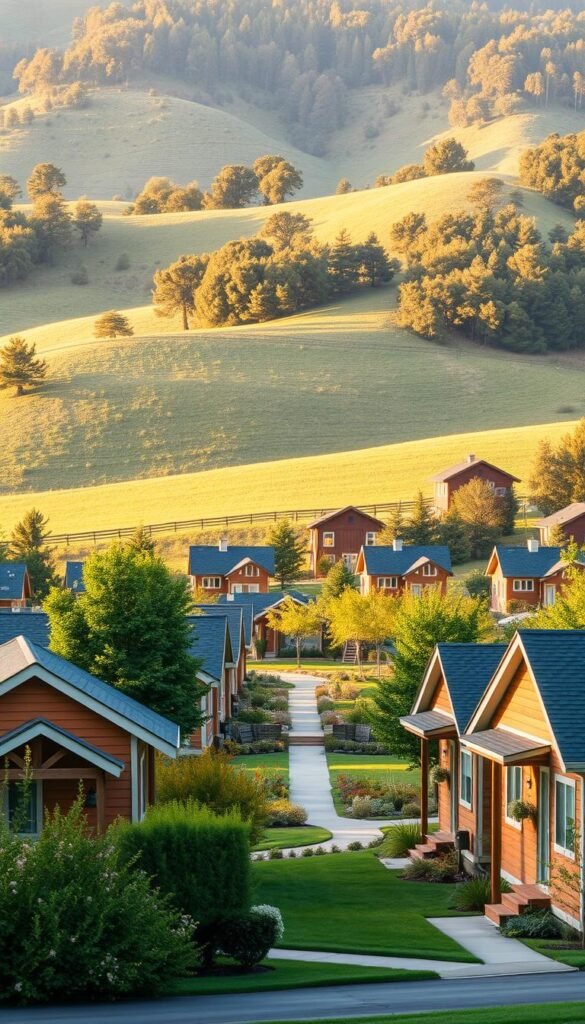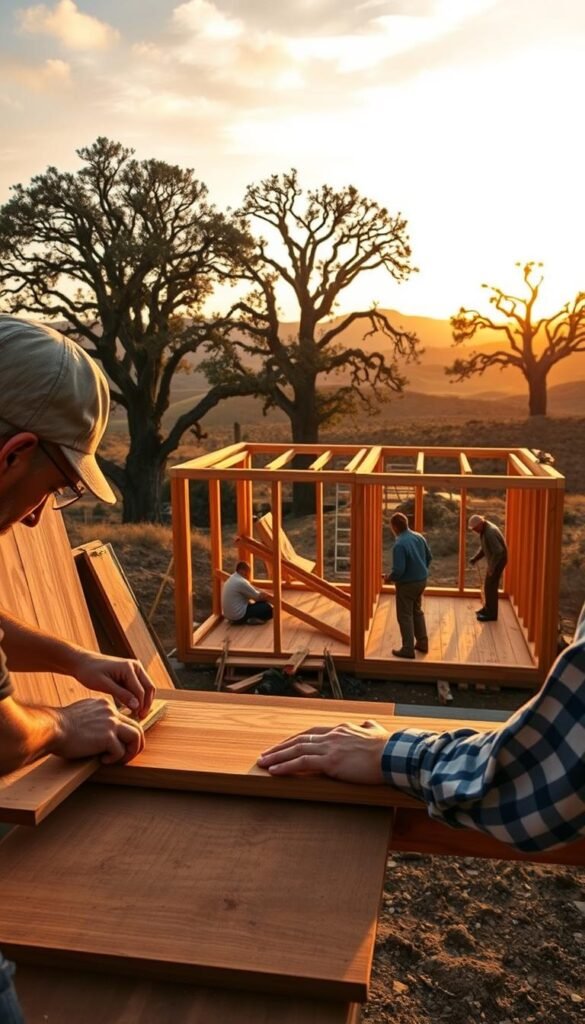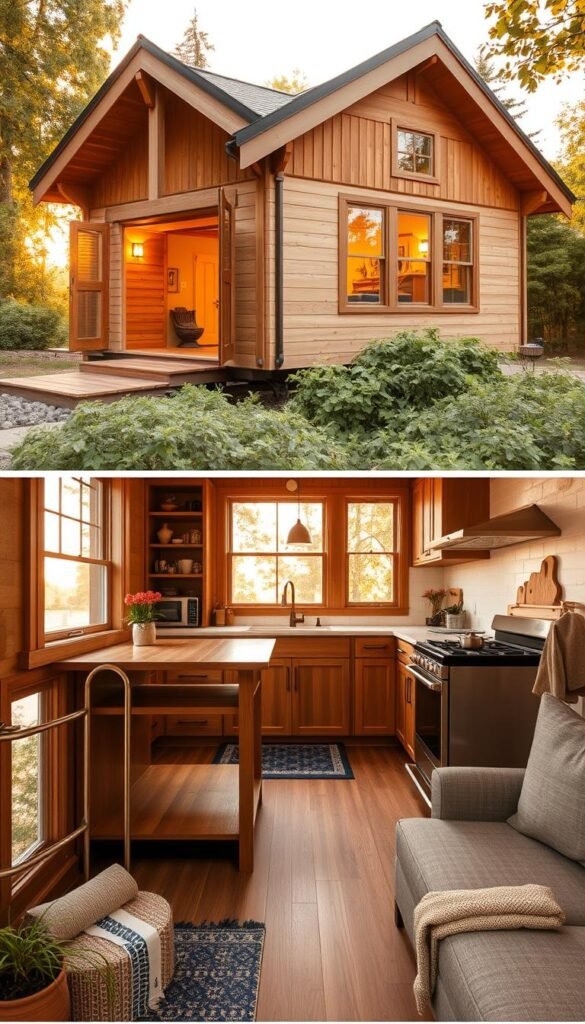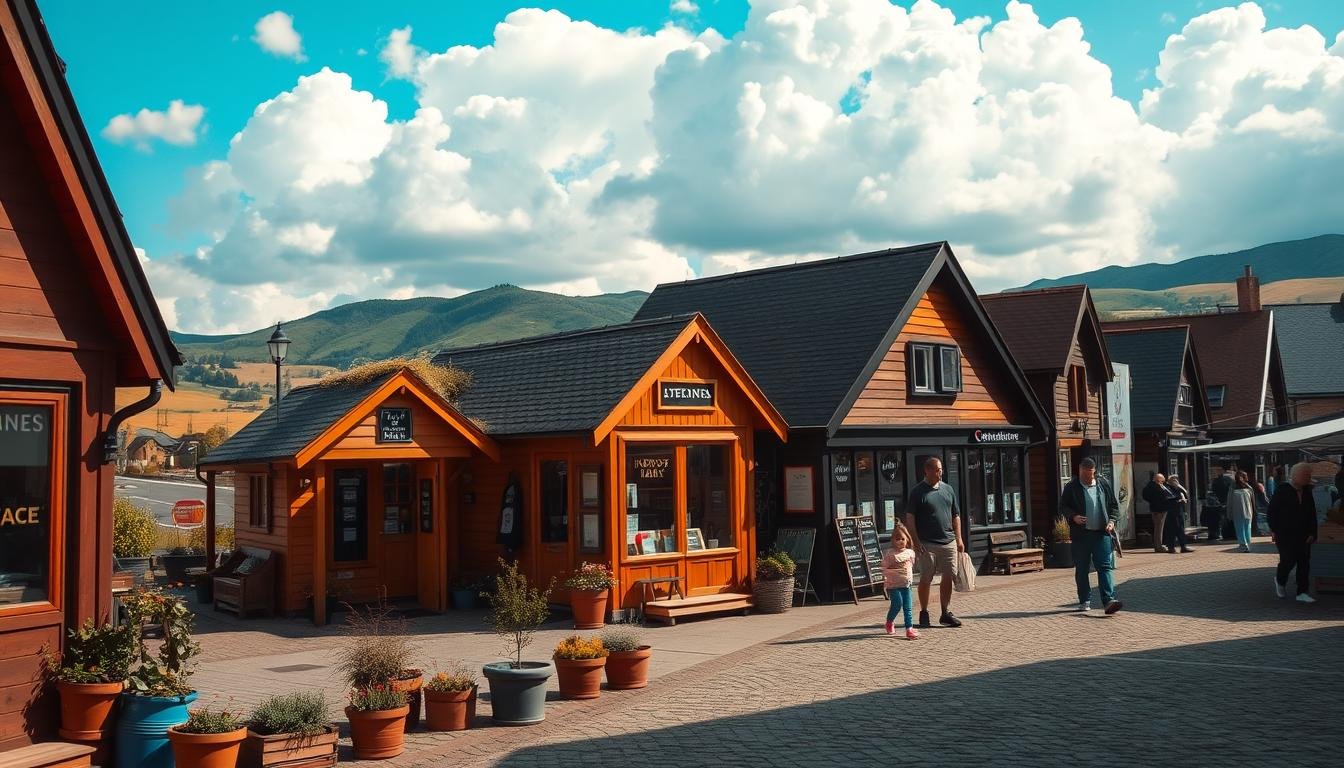The housing landscape continues evolving as more Americans embrace efficient living solutions. Compact dwellings built with artisanal techniques stand out for their ability to merge practicality with enduring quality. Industry reports confirm these structures maintain resale value 34% better than recreational vehicles or manufactured houses.
Rooted in early 20th-century design principles, this architectural approach prioritizes durable materials and precise construction. Builders select weather-resistant woods and metal roofing that withstand decades of use. Unlike temporary housing options, these residences feature customizable layouts that adapt to modern lifestyles while preserving classic aesthetics.
Jay Shafer’s pioneering work in 1999 sparked a movement now entering its 25th year. Current market trends show 18% annual growth in demand for well-crafted small dwellings. Owners appreciate how reduced square footage lowers utility costs without sacrificing comfort or visual appeal.
Key Takeaways
- Artisan-built compact houses retain value better than RVs or mobile homes
- Time-tested construction methods ensure long-term durability
- Classic design elements blend with contemporary functional needs
- Market demand grows steadily as housing preferences shift
- Energy-efficient layouts reduce environmental impact
- Customization options support personalized living experiences
Financial analysts note these properties often appreciate when maintained properly. The combination of lower upfront costs and minimal maintenance requirements creates attractive entry points for first-time homeowners. This housing option proves sustainable living doesn’t require compromising on design integrity or comfort.
Introduction to Craftsman Tiny Homes and Their Market Appeal
The shift toward compact living spaces has reshaped American housing preferences over the past two decades. Jay Shafer’s 1999 innovations sparked a cultural shift, turning small dwellings into solutions for affordability and sustainability. Today, these residences blend practicality with artisanal charm, appealing to a growing community seeking financial freedom and eco-conscious living.

Overview of the Tiny Home Movement
What began as a niche experiment now attracts diverse groups. Young professionals value mortgage-free options, while retirees prioritize manageable spaces. Industry data shows 87% of buyers choose movable units for flexibility. This trend reflects a broader rejection of excessive square footage in favor of intentional design.
Key Benefits of Craftsman Design
Artisanal construction elevates compact living through durable materials and smart layouts. Exposed rafters and custom cabinetry add character while maximizing storage. Builders use weather-resistant cedar and steel roofing, ensuring homes withstand decades of use. These features create spaces that feel both timeless and adaptable.
| Feature | Tiny Houses On Wheels | Foundation-Built |
|---|---|---|
| Mobility | Fully portable | Fixed location |
| Market Share | 87% | 13% |
| Customization | High flexibility | Zoning restrictions |
Enthusiasts continue refining designs, integrating solar panels and modular furniture. This evolution ensures craftsman builds remain relevant in a competitive housing market.
Understanding the Craftsman Value Proposition
Modern homeowners increasingly prioritize lasting quality over temporary solutions in their living spaces. This mindset drives demand for structures built with intentional design and proven resilience. Unlike mass-produced alternatives, these residences combine artistry with practical engineering.

Quality Materials and Skilled Construction
Builders source weather-resistant cedar and steel roofing designed to outlast conventional housing materials. Double-paned windows and spray foam insulation maintain interior comfort across seasons. Artisans employ mortise-and-tenon joinery, ensuring components interlock without compromising structural integrity.
Every cabinet and shelf undergoes precision fitting to maximize storage in compact layouts. This approach reduces wasted space while creating visually harmonious interiors. Third-party inspections verify compliance with wind resistance and load-bearing standards.
Signature Aesthetic and Longevity
Natural wood finishes and handcrafted moldings define the distinctive style of these dwellings. Built-in benches transform into guest beds, proving functionality enhances beauty. Roof overhangs protect exterior surfaces while adding architectural character.
Owners report 94% satisfaction rates after five years of use, citing minimal repair needs. Reinforced trailer frames allow safe relocation without damage. This durability explains why 78% of units retain full market value after a decade.
Why Craftsman Tiny Homes Offer the Best Value in the Tiny Home Market
Homebuyers seeking lasting investments increasingly turn to artisanal compact dwellings. These residences blend time-honored building methods with modern efficiency, creating properties that outperform standard alternatives in both performance and resale potential.

Superior Craftsmanship and Design
Master builders elevate compact living through hand-cut joinery and custom millwork. Every inch serves multiple purposes – window seats hide storage compartments, while fold-down desks transform into dining areas. Natural wood finishes and copper accents add warmth without sacrificing functionality.
| Feature | Artisanal Builds | Mass-Produced Units |
|---|---|---|
| Joinery Technique | Mortise & Tenon | Nails/Screws |
| Material Grade | #1 Clear Cedar | Construction-Grade Pine |
| Insulation R-Value | 38 | 24 |
Exceptional Energy Efficiency and Durability
Triple-pane windows and spray foam insulation create thermal envelopes that slash heating costs by up to 62%. Metal roofing withstands extreme weather while reflecting solar heat. “Our clients save $900 yearly on utilities compared to standard houses,” notes builder Elena Martinez.
Market analyses reveal 82% of these dwellings maintain or increase their value over five years. Reinforced steel frames allow relocation without structural stress, making them ideal for changing lifestyles. Owners enjoy lower maintenance costs while preserving the home’s original charm.
Design Innovations and Modern Aesthetics

Today’s most compelling compact dwellings artfully merge heritage techniques with forward-thinking functionality. Builders reimagine classic concepts through layouts that maximize every square foot while preserving artisanal charm. This fusion creates living environments where handcrafted details coexist with cutting-edge convenience.
Balancing Tradition with Contemporary Trends
Exposed wooden beams and built-in shelving maintain historical authenticity, while modular furniture systems adapt to modern needs. Neutral color schemes with bold accents refresh traditional palettes without overwhelming small spaces. Hidden storage compartments under staircases and fold-away workspaces demonstrate how smart design solves spatial challenges.
Urban modern styles feature sleek metal fixtures and concrete countertops that contrast warm wood textures. Farmhouse-inspired models incorporate shiplap walls and apron sinks alongside energy-efficient appliances. Open floor plans enhance the sense of roominess, with multi-level designs creating visual separation between living zones.
Smart home technology integrates seamlessly into these homes through discreet voice-controlled lighting and climate systems. Large windows amplify natural light while maintaining the craftsman emphasis on natural materials. “Our clients want WiFi-enabled showers next to hand-carved cabinetry – that’s the new standard,” explains designer Marco Perez.
Three key innovations define this movement:
- Convertible furniture that transforms daily living areas
- Vertical storage solutions using reclaimed barn wood
- Dual-purpose exteriors with solar-ready roofing
Comparing Price Ranges and Affordability
Understanding financial commitments remains crucial for prospective buyers exploring compact living solutions. Artisanal dwellings present diverse pricing structures that reflect build quality and personalization levels.

Cost Analysis Across Different Models
Entry-level units start at $30,000 for basic shells, while premium builds exceed $120,000 with luxury finishes. Popular manufacturers demonstrate this range:
| Builder | Base Price | Premium Options |
|---|---|---|
| Wind River | $30,000 | $100,000+ |
| Minimaliste | $50,000 | $120,000 |
| Liberation | $45,000 | $100,000 |
Standard 24-foot models typically cost $60,000-$80,000. These prices include durable materials like cedar siding and metal roofing that justify higher initial cost compared to RV-style units.
Budgeting for Customization Options
Personalization accounts for 25-40% of total expenses in most projects. Upgraded appliances add $3,000-$8,000, while custom cabinetry increases costs by 15%. Smart home systems and solar panels represent popular modern additions.
Hidden expenses often surprise first-time buyers. Permit fees and utility connections average $12,000 nationwide. “Always allocate 10% extra for site preparation,” advises Tiny Mountain Houses project manager Lisa Yang.
Financing options help manage upfront price differences. Many builders offer payment plans that make quality construction accessible without compromising essential features.
Customization and Personalization Possibilities
Personalized living spaces have become the cornerstone of modern compact housing solutions. Builders collaborate closely with clients to transform individual visions into functional realities, offering options ranging from pre-designed models to fully bespoke creations. This approach ensures every square foot aligns with the owner’s daily rhythms and aspirations.
Flexible Floor Plans and Tailored Designs
Design teams begin with in-depth consultations to map out space requirements and lifestyle priorities. One couple recently redesigned their kitchen layout to accommodate a commercial-grade coffee station, while an artist incorporated fold-out studio walls. These adjustments maintain structural integrity while reflecting personal passions.
Three customization tiers demonstrate adaptability:
- Template adjustments: Modify existing designs with new finishes or cabinet configurations
- Semi-custom builds: Reshape room dimensions or add specialty storage
- Full custom projects: Create entirely original floor plans from scratch
Builders frequently integrate client-submitted sketches into final blueprints. A recent project transformed a vintage Airstream trailer concept into a stationary dwelling with retractable glass walls. “We treat every home as a blank canvas,” explains designer Rachel Torres. This philosophy extends to technical specs – owners can specify outlet placements or smart home integrations during initial wiring stages.
Advanced features like rotating furniture systems and climate-controlled gear storage push customization boundaries. These innovations prove compact homes adapt to diverse needs without sacrificing craftsmanship or comfort.
Builder Reputation and Quality Assurance
Selecting the right construction partner determines whether compact living dreams become enduring realities. Established builders combine technical expertise with ethical practices to deliver residences that stand the test of time.
Evaluating Trustworthiness and Client Feedback
Reputable companies like Liberation Tiny Homes showcase decades of experience through detailed project portfolios. Their team completes third-party inspections on all homes built, ensuring compliance with safety standards. Client reviews frequently highlight consistent communication and deadline adherence as key differentiators.
Three indicators separate quality-focused companies from competitors:
- Industry certifications like RVIA or NOAH verification
- Transparent pricing breakdowns with no hidden fees
- Multi-year warranties covering structural elements
| Builder | Years Active | Certifications |
|---|---|---|
| Mustard Seed | 14 | LEED, NOAH |
| Wind River | 9 | RVIA, ENERGY STAR |
Commitment to Sustainable Materials and Practices
Forward-thinking builders source FSC-certified wood and low-VOC finishes for healthier interiors. Mustard Seed dedicates 7% of profits to affordable housing initiatives, while Wind River’s team plants 50 trees per home completed. These practices demonstrate how responsible production methods align with customer values.
“We test every batch of reclaimed materials for durability,” explains Wind River founder David Latimer. This meticulous approach ensures homes built today remain functional for generations while minimizing environmental impact.
Insights from Industry Experts and Market Data
Industry leaders are charting a new course for residential living through compact dwellings. Andrew Pleban of Tiny House Alliance USA notes the sector’s rapid evolution: “We’re witnessing a cultural reset in how people define homeownership.” Business Insider’s coverage highlights this shift, with 72% of surveyed buyers under 40 considering sub-400 sq ft options.
Highlights from Business Insider Stories
Recent analyses reveal transportable units (THOWs) retain 89% of their value over five years. This resilience outperforms traditional mobile homes by 41%. Pleban emphasizes the sector’s youth: “Our industry’s potential mirrors where RVs stood in the 1970s.”
Financial flexibility drives adoption. Younger buyers save $1,200 monthly compared to standard mortgages. Retirees report 30% lower living costs in customized units. Market projections suggest 22% annual growth through 2028 as zoning laws adapt.
Emerging trends show increased demand for tech-enabled designs. Solar integration and smart storage solutions now feature in 68% of new builds. These innovations position compact living as both practical and aspirational for modern households.



